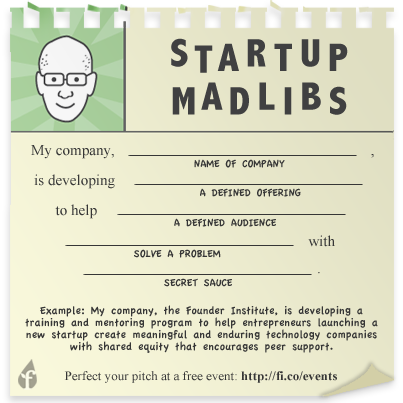
A startup needs plenty of steady capital in order to survive and, ultimately, to thrive. Whether it's in the form of investor funding or a strong customer base, every company relies on the financial resources of others to grow.
But how can founders convince other of the viablility of their offering in a compelling way?
Luckily, this blog post dives deep into how entrepreneurs can fashion their pitch in a way that will attract the attention of anyone - including investors, customers, co-founders, and more - featuring insights from Carter Laren, co-founder and Managing Partner at Gateway Incubator.
Don’t Pivot, Persevere
For too many founders, ideas are a dime a dozen. Founders are constantly coming up with ideas, whether it’s in the shower, on the drive to work, while having dinner with the family, or in any other everyday situation. Even if they’re already running a company, founders are almost always coming up with ideas about other products to build.
However, while it’s important to always have new ideas, to always be innovating, founders must realize that when they set out to build a startup, they are basically working on their life’s work. Just because you’ve gotten bored with your current venture doesn’t mean that you should give it up and begin work on something else.
Before you begin working on a new idea, you first need to evaluate why you’ve chosen that particular idea to work on. Don’t set out to launch a company if you’re reasons align with any of these:
-
You want to be the boss. Even top CEOs have to answer to others, whether it’s a board of directors, advisors, employees, customers, etc.
-
You think launching a company will be fun. Launching a company is incredibly hard, stressful, and time-consuming.
-
You want to get rich quick. During the first few months, or even years, of launching a startup, you and your company will be scrambling to cover basic costs.
In short, there are much better, lucrative, and less stressful career paths to consider before just launching a startup.
However, if none of the above reasons factor into why you want to build a startup, then you may have what it takes to be an entrepreneur. If you want to build a startup because you think you can make a positive impact on the world and you are able to stick to that reason even when things are looking bad for your company, your experience will be more rewarding and fulfilling.
Important Tips to Keep in Mind Before You Pitch Your Startup
When you are first startup up, it’s not just investors you’re going to have to pitch. You’re going to have to pitch your company to potential co-founders and team members, prospective customers, mentors and advisors, and many others.
And that’s why it’s so important to have a definitive reason for why you’re launching a startup. That reason is how you can convince co-founders to help bring your idea to life, convince team members to work for almost no money, and convince other companies to partner with you.
Also, there is belief that’s prevalent throughout the startup world, and especially in Silicon Valley, that pitching is all about talking at your audience and that, once done, they will be convinced of your idea. This is wrong. For early-stage founders, pitching should be more of a conversation, one that engages their audience and encourages them to ask questions about the idea.
Basically, instead of merely dumping long sentences about your idea and market size on your audience, approach them in a way you would approach a friendly acquaintance. Start by introducing yourself and your background and ask them about themselves, then gracefully segue into your idea.
Stop Using Superlatives in Your Startup Pitch
Investors hate to be told conclusions. Investors hate to be told what to think. And they hate to be told how great your company is. When pitching to investors, it’s important to only give them the facts of your company and to let them determine if your company is worth investing in.
And the best way to do this is stop using superlatives in your startup pitch. If you don’t know what a superlative is, Oxford Dictionaries defines it as “an exaggerated or hyperbolical expression of praise”. This means that you should stop using words like “revolutionary”, “game-changing”, “disruptive”, and others to describe your company. Not only are these types of words overused in the startup world, but using them makes you sound presumptuous.
Instead of using exaggerated words and phrases to describe your company, focus on how your offering solves a widespread market, why you’re most qualified to lead this company, and any traction that your company has achieved since launching.
Remember, facts will always be more effective than opinions.
Should You Tailor Your Startup Pitch for Different Audiences?
Whenever you’re starting a new company, whether it’s your first or one or not, it’s important to keep the “why” of your startup (the reason you’re launching this company) the same. When you’re meeting with vendors, investors, potential co-founders, first team members, or new customers, your intentions and motivations need to remain static. If your passion for launching a startup changes with every person you meet, you will only put your reputation at risk and establish yourself as disingenuous.
In short, take the time to clearly establish your “why” for launching your startup and be sure to infuse it into the beginning of every version of your startup pitch.
Now, for the later portions of your startup pitch, you should definitely create a variety of talking points tailored for specific audiences. Keep in mind that as you describe what your company is and what it does, that you’re not talking “at” your audience so much as you’re talking “to” them. For example, the details that are important for investors to know may not be necessary for recruiting co-founders, and the pitch you give to co-founders should be different from the pitch your give to vendors, and so on.
Basically, it’s necessary to create numerous types of pitches for your company, as each should have its own distinct purpose.
How Do You Talk to Investors?
Even if you’re an experienced entrepreneur or businessperson, or you have a billion dollar idea on your hands, you still have to put in the work to perfect the overall presentation of your startup pitch.
For example, if you’re meeting investors at an event, conference, or mixer, it’s essential to present your idea in a conversational tone. For beginning founders, it’s tempting to cram your life story and everything that led up to the conception of your startup into one sentence. But blasting a potential investor with a barrage of information is a terrible way to generate interest in what you have to say. Focus on being casual, concise, and friendly, as this will keep investors, well, invested in your idea.
Another tip to keep in mind is that when you giving your startup pitch, investors are evaluating you just much as, if not more than, they’re evaluating your idea. Take brief pauses in between sentences to give them an opportunity to offer feedback. And remember, whatever you do, DO NOT get defensive when they question the viability of your idea, as investors are also gauguing you on how open you are to new ideas and how well you collaborate.
How Do You Find Your Startup’s Secret Sauce?
In the rush of launching a new startup, it’s easy for founders to develop the belief that their idea can solve a widespread problem and change the world in the process. This is wrong. Just because you perceive something to be a problem or an inefficiency, it does not mean that it is. Countless entrepreneurs have created “solutions” to what they thought were problems, only to have the product fail in a short amount of time. The problem is that they were solving the wrong problem or that they set out to solve something that wasn’t a problem to begin with. Like putting a bandaid on a bullet wound, building a solution for a nonexistent problem is utterly pointless.
The best way to overcome this feeling, and also to discover what sets your offering above others, is to conduct massive amounts of research into the problem you want to solve. Meet with the people who would actually used your product and take extensive notes on their routines and lifestyles to really determine what problems need to be solved. During this process, you may discover that what you thought was a problem isn’t a problem for your customers.
If you want even more tips on perfecting your startup pitch, check out the resources below:

Did you know that [CUSTOMER CATEGORY] experience [MASSIVE PAIN]? This is a [MARKET SIZE] billion dollar opportunity in the US alone. [PRODUCT NAME] is a [PRODUCT CATEGORY] that [VALUE PROPOSITION]. Unlike other alternatives we, [KEY DIFFERENTIATOR]. The team includes [CREDIBLE TEAM BIOS] and we make money by [BUSINESS MODEL]. In essence, we are the [WELL-KNOWN ANALOGUE]for [ANALOGUE PRODUCT CATEGORY] and our vision is to [HOW WILL THE WORLD BE DIFFERENT? WHY DO YOU CARE?]. We have already [EXECUTED MILESTONES] and you are must be involved because [INVITE!].





